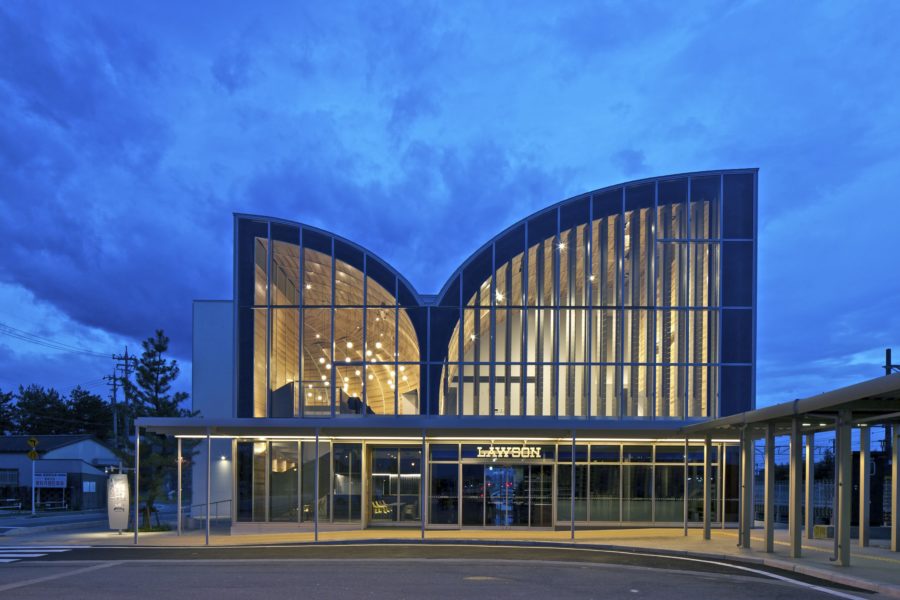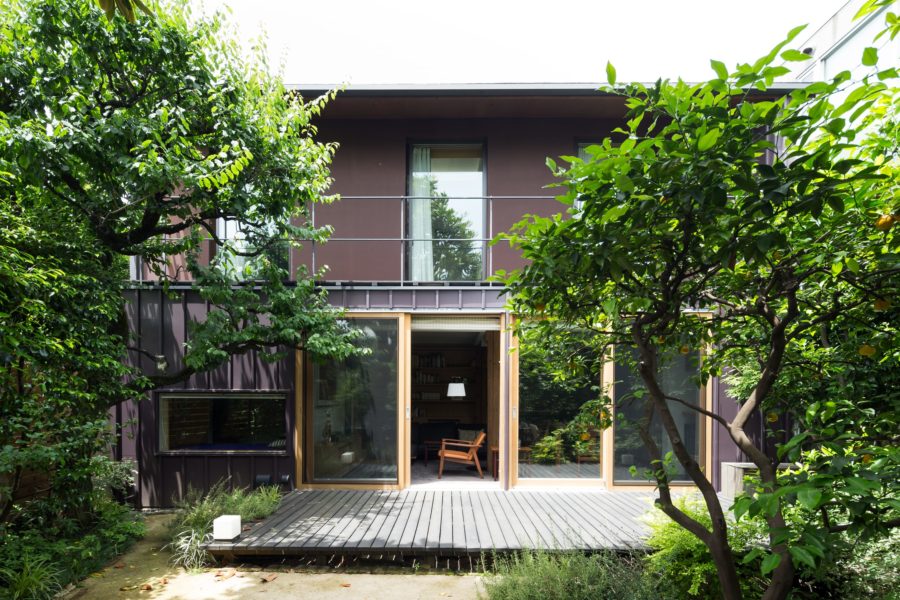2020年で創業70周年を迎えた製薬会社である全薬工業の研究開発拠点の移転新築計画である。
昨今の研究内容は細分化・専門化しながらも、オープンラボのような外部企業との協働やベンチャー企業との協同、一部の研究作業の外注化など研究環境は多様化している。
実験室にはこれまで以上の高い性能と環境が要求され、研究所としては外部との繋がりや研究者同士の繋がりがきわめて重要なテーマとなってきている。
そこで本計画では「敷地全体を閉じる」という既成のビルディングタイプ形式から、「ラボ部分を閉じ、研究所全体としては開かれている」という形式へ変換することを試みた。
建築のテーマとしてはありきたりな「開かれた」という言葉ではあるが、研究所というビルディングタイプにおいては大きな意味をもつと考えた。
構成としては、オフィスゾーン・ラボゾーン・設備シャフトゾーンを平面的に明快に分け、細長い建物に対して3枚下ろしのように細長く3つの用途をゾーニングした。これにより、奥行きが浅く外部環境に近いオフィスゾーン、設備シャフトが近くフレキシビリティの高いラボゾーンを獲得している。
研究分野によって求められる気密性・遮音性・清浄度・温度安定性が異なる中で保守性・更新性といった将来のフレキシビリティにも配慮して、ラボゾーンは実験台寸法から建物スパンを決定し研究分野ごとにスタッキングしていく計画とした。
一方でオフィスゾーンについては、研究分野の分け隔てのない一体の共有空間とし、研究者同士のコミュニケーションがとりやすい計画とした。京王線沿いの北側にオフィスゾーンを配置することで、眺望や京王線沿いの豊かな景観、安定した北側採光を獲得している。
防虫対策のため室内に植栽を設置できない代わりに、オフィスゾーン外周にはバルコニーやテラスを設け植栽を施すことで、室内景観を向上するとともに都市景観と親和性の高い外観イメージとしている。
「開かれた」というテーマの中で、空間として内外を連続させるモチーフとして下面を鏡面状に仕上げた天井アルミルーバーを計画した。
空間のスケールに合わせてルーバー断面およびピッチを(W)50mm×(H)200mm @320mmに設定し、上面・側面を黒色、下面を電解研磨で仕上げることで環境を映し込む鏡面を生み出した。見る人の位置や向きにより外構の植栽、内部空間、都市の喧騒が移り変わっていく。
ルーバーの下面を鏡面状の面として徹底して設えるため、障害となるものや光の映り込みを排除することを考えた。
ルーバー間に設置されるダウンライトのような設備の設置高さをルーバー下面より可能なかぎり上げることを基本とし、さらに視覚的な障害となるダウンライトによるスカラップやグレアが出ないよう計画した。具体的には、ダウンライトのレンズ、バッフルプレートを操作しルーバー側面にスカラップが落ちない配光曲線をつくるとともに、ルーバー側面を0.8mmの山型形状とすることでルーバー側面にダウンライトの光源が映り込まない仕組みとした。(頭井秀和)
A new type of research facility that opens while closing by reflecting the environment with a mirror louver
We plan to relocate and build a new research and development base for Zenyaku Kogyo, a pharmaceutical company that will celebrate its 70th anniversary in 2020.
The research environment has become more diversified in recent years, as research content has become more segmented and specialized. In contrast, collaborations with outside companies such as open labs, cooperation with venture companies, and outsourcing of some research work have become more common.
Laboratories are required to have a higher level of performance and environment than ever before. Therefore, connections with the outside world and other researchers are becoming extremely important for research institutes.
Therefore, in this project, we attempted to convert the existing building type format of “closing the entire site” into “closing the laboratory part but opening the entire institute.”
Although the word “open” is a common architectural theme, we thought it would have great significance in the building type of a laboratory.
The office zone, laboratory zone, and equipment shaft zone are divided in the plan, and the three uses are zoned in a long and narrow manner as if they were three sheets down on a long and narrow building. As a result, the office zone is shallow and close to the external environment, and the laboratory zone is close to the equipment shaft and has high flexibility.
While the airtightness, sound insulation, cleanliness, and temperature stability required by each research field differ. We determined the laboratory zone’s building span based on the laboratory benches’ dimensions in consideration of future flexibility in terms of maintainability and renewability, and stacking was planned for each research field.
On the other hand, the office zone was designed to be a single shared space that does not divide the research fields and allows for easy communication among researchers. By locating the office zone on the north side of the Keio Line, we have obtained a view, a rich landscape along the Keio Line, and stable lighting on the north side.
Instead, balconies and terraces around the periphery of the office zone are planted to enhance the interior view and create an exterior image that is highly compatible with the urban landscape.
In keeping with the theme of “openness,” we planned aluminum louvers on the ceiling with a mirror-like finish on the underside as a motif to create continuity between the interior and exterior spaces.
The louver cross-section and pitch were set to (W)50 x (H)200mm @320mm to match the scale of the space. The top and sides were finished in black, and the bottom surface was electropolished to create a mirrored surface that reflects the environment. Depending on the position and direction of the viewer, the exterior plantings, interior space, and the bustle of the city will change.
To thoroughly set up the underside of the louvers as a mirror-like surface, we considered eliminating obstacles and reflections of light.
We raised the height of the equipment installed between the louvers as much as possible above the louvers’, and we also made the plan to avoid scallops and glare from the downlights, which are visual obstacles. Specifically, we manipulated the lenses and baffled plates of the downlights to create a light distribution curve that would not cause scallops to fall on the sides of the louvers. And we made the sides of the louvers into a 0.8mm mountain shape to prevent the light source of the downlights from reflecting on the sides of the louvers. (Hidekazu Zui)
【全薬工業 研究開発センター】
所在地:東京都八王子市南大沢4-7-1
用途:研究施設
クライアント:全薬工業
竣工:2021年
設計:日建設計
担当:頭井秀和、水野悠一郎、チン・シャンリン、河野 信
構造設計:日建設計
施工:大林組
照明:岡安泉照明設計事務所
什器:日建スペースデザイン
サイン:デザイン事務所atrium
撮影:yukikazu ito. / 雁光舎(野田東徳)
工事種別:新築
構造:鉄骨造 一部 鉄骨鉄筋コンクリート造
規模:地上4階 地下1階
敷地面積:16,733.31m²
建築面積:4,763.72m²
延床面積:13,895.02m²
設計期間:2017.08-2018.12
施工期間:2019.07-2021.02
【Zenyaku Kogyo R&D CENTER】
Location: 4-7-1 Minami Osawa, Hachioji-shi, Tokyo, Japan
Principal use: Research facility
Client: Zenyaku Kogyo
Completion: 2021
Architects: Nikken Sekkei
Design team: Hidekazu Zui, Yuichiro Mizuno, Chin Shanlin, Shin Kawano
Structure engineer: Nikken Sekkei
Contractor: Obayashi
Lighting Design: Izumi Okayasu Lighting Design
Furniture: NIKKEN SPACE DESIGN
Signage: atrium
Photographs: yukikazu ito. / Gankosha (Harunori Noda)
Construction type: New Building
Main structure: Steel, partially steel-framed reinforced concrete structure
Building scale: 4 Stories, 1 floor below ground
Site area: 16,733.31m²
Building area: 4,763.72m²
Total floor area: 13,895.02m²
Design term: 2017.08-2018.12
Construction term: 2019.07-2021.02








